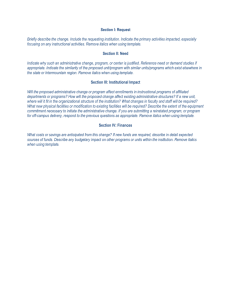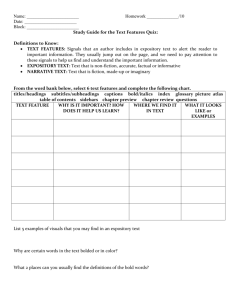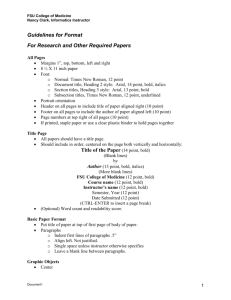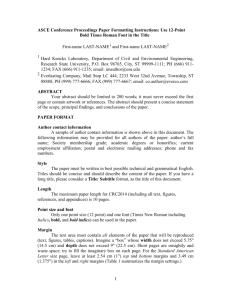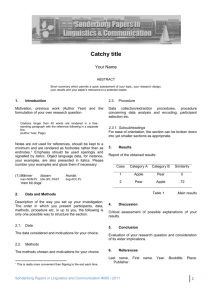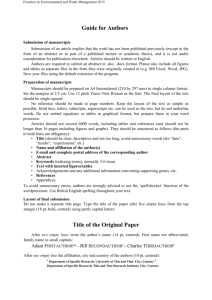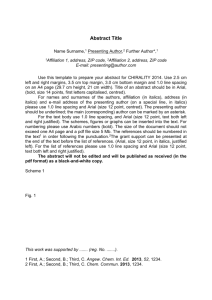template for the layout/formatting of manuscripts to be submitted to
advertisement
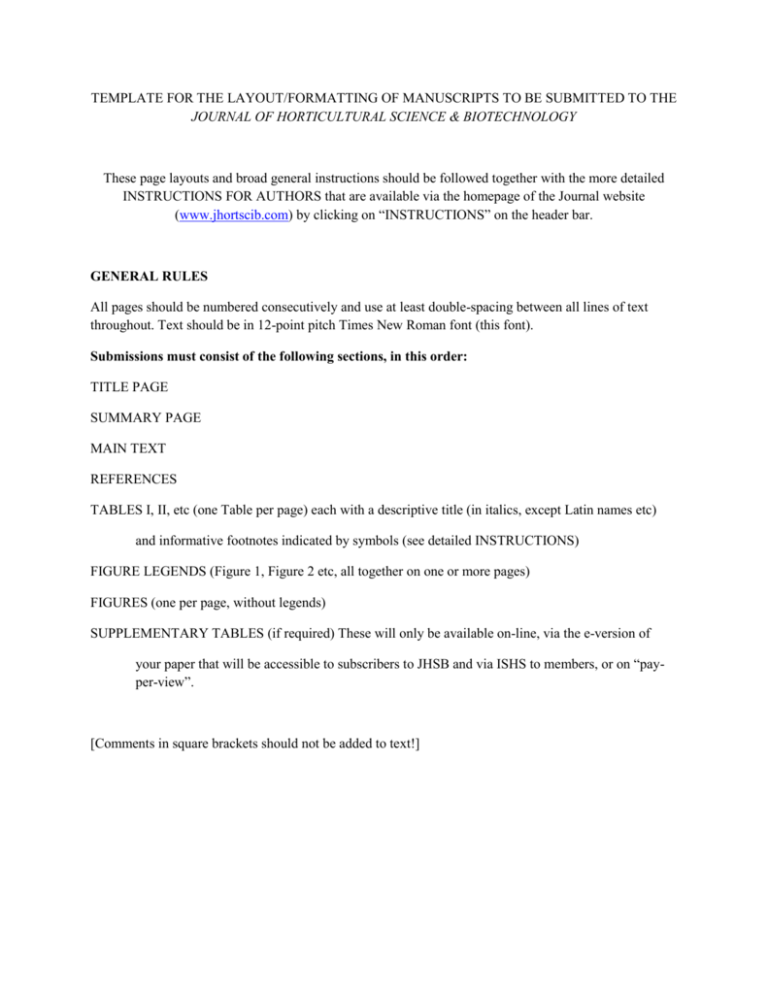
TEMPLATE FOR THE LAYOUT/FORMATTING OF MANUSCRIPTS TO BE SUBMITTED TO THE JOURNAL OF HORTICULTURAL SCIENCE & BIOTECHNOLOGY These page layouts and broad general instructions should be followed together with the more detailed INSTRUCTIONS FOR AUTHORS that are available via the homepage of the Journal website (www.jhortscib.com) by clicking on “INSTRUCTIONS” on the header bar. GENERAL RULES All pages should be numbered consecutively and use at least double-spacing between all lines of text throughout. Text should be in 12-point pitch Times New Roman font (this font). Submissions must consist of the following sections, in this order: TITLE PAGE SUMMARY PAGE MAIN TEXT REFERENCES TABLES I, II, etc (one Table per page) each with a descriptive title (in italics, except Latin names etc) and informative footnotes indicated by symbols (see detailed INSTRUCTIONS) FIGURE LEGENDS (Figure 1, Figure 2 etc, all together on one or more pages) FIGURES (one per page, without legends) SUPPLEMENTARY TABLES (if required) These will only be available on-line, via the e-version of your paper that will be accessible to subscribers to JHSB and via ISHS to members, or on “payper-view”. [Comments in square brackets should not be added to text!] [Title page] Journal of Horticultural Science & Biotechnology (2012) 87 (x) xxx-xxx TITLE OF YOUR PAPER [14-16 point pitch in large roman capitals, not bold, not italics except for the Latin names of species, in vitro, etc. No non-standard abbreviations.] _______________________________________________________ [bold single line] By A. B. SMITH1, B. C. SMITH2,5* and C. D. SMITH1,3 [Or all authors can use full first names, middle initials, and surnames, but not a mix of both formats] [Use sequential superscript numbers 1, 2 etc to specify full current postal addresses, including street names and zip codes, for each author.] [Can use additional superscript numbers for footnotes on the Title page such as 4Present address: ……. 5 These authors contributed equally to this work.] [Use a superscript asterisk (*) to specify the *Author for correspondence.] (e-mail: …) [e-mail address of the corresponding/main author only] (Accepted xxxx 2012) [italics] Running Head: [a 6-8 word phrase that summarises the full TITLE above. In italics. No Keywords.] [Do not provide a list of abbreviations used. Abbreviations should be defined at their first use in the SUMMARY and again in the main text.] *Author for correspondence. 1 [Summary page] SUMMARY [large capitals, not bold, not italics] [A single 200 - 400 word paragraph with no Reference citations. Not indented on line 1. Define any abbreviations at their first use here (and again in the main text). The first two or three sentences should introduce the study, the reason for doing it, and the hypothesis being tested. Then give the main quantitative and/or qualitative results, and finally the major conclusion(s) of the paper.] 2 [Main text] H orticultural production……… [first line of text not indented, drop capital for first letter] [No extra lines between paragraphs. No main heading (do not use INTRODUCTION) or subheadings in the introductory sub-section.] [References should be quoted here and elsewhere in the main text in parentheses as (Smith, 2009; Smith and Jones, 2010; Smith et al., 2011).] [Refer to Figures in the main text as (Figure 1; Figure 2; etc) and to Tables as (Table I; Table II; etc.] MATERIALS AND METHODS [= main heading, in capitals, not bold, not italics] Plant material and cultivation [= subheading, in italics, not bold, start text on next line, indent first line] Apple (Malus x domestica Borkh.) trees (n = 24) were selected at random in an orchard at……. Biochemical analyses [= next subheading, as above] Total soluble sugars contents (TSSC): Leaf samples (5.0 g) were removed from………. [= first sub-subheading, in italics, not bold, and start the text on the same line] Calcium ion concentrations: Samples of fruit (10.0 g) were……..[= next sub-subheading, as above] Statistical analysis of the data [= next subheading, in italics, not bold, start text on the next line, indent first line.] All percentage values were arc sin transformed before……. RESULTS [= main heading, in capitals, not bold, not italics. Text may be organised and presented using the same sub-headings and sub-subheadings as in the previous section. Indent first line of text.] These experiments show that treatment of apple with……… DISCUSSION [= main heading, in capitals, not bold, not italics, indent first line of text] [Alternatively, you can have a combined RESULTS AND DISCUSSION section.] CONCLUSIONS [= main heading, in capitals, not bold, not italics, indent first line of text. Be brief, do not repeat the text of the SUMMARY] [Add 1 extra line spacing] [Any acknowledgement of funders (with Project Nos.), any special suppliers, technical assistants, colleagues, etc. Do not use main heading ACKNOWLEDGEMENT.] REFERENCES [= main heading, in capitals, not bold, not italics. Arrange all cited References in alphabetical order by first author, then by number of co-author(s) and in chronological order. Do not number each citation. See detailed formats for listing research journal papers, chapters in books, books, monographs, etc in the full INSTRUCTIONS for authors on the website. For example: ADAM, A.B., SMITH, B.C. and JONES, C.D. (2011). Effects of compound X on parameter Y in plant Z (Latin species name, in italics). Journal Name [in italics], volume number [in bold], xxx-xxx.] [Last page number of main text] TABLE I [example] Brief descriptive title for Table [in italics, except for words otherwise in italics. Use footnotes with symbols (see website) for defining complex parameters and any statistical analyses applied] ___________________________________________________________________ [bold line] [Column captions (with units for data columns)] Year Treatment Sugar concentrations (mg g-1 FW) TA# Firmness (N) …… ________________________________ [light short line] Glucose Fructose Sucrose ___________________________________________________________________ [light line] Columns of parameters and data* ___________________________________________________________________ [bold line] [Examples of footnotes: TA, in malic acid equivalents, etc…… # *All values are means +/- SD (n = ??). Mean values in each column/row followed by the same lower-case letter(s) are not significantly different (P < 0.05) by the ????? test.] [Each following TABLE (II, III etc) should be on a new page] [New page] FIGURE Legends [all gathered together sequentially and numbered FIG. 1, FIG. 2 etc] [Each legend should make the relevant Figure fully comprehensible to the informed reader, without having to refer to the main text to explain what is being shown. The legend should describe all the variables, symbols, units, and scale bars used in each Panel (A, B, etc), and any other features specifically marked on each Panel of each Figure.] [New page(s)] [Each Figure should then be presented on a separate page, with FIG. 1, FIG. 2, etc, below it. Formatting details are available on the website (www.jhortscib.com) or by reference to recent past issues of the Journal. Avoid three-dimensional graphic effects for bar charts, the unnecessary use of colour, complex hatched patterns for filling-in bars on histograms, symbols that are too large or too small, lines that are too thin or too thick (obscuring symbols and error bars), and define the dependent and independent variables used (with their units) on each x-axis and y-axis of all graphs in each Panel A-Z. Ensure that the print quality of all captions, lines, and symbols is clear and of high resolution for publication.]
